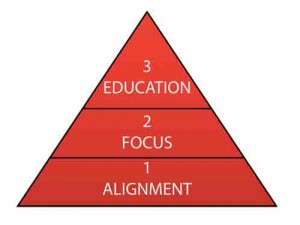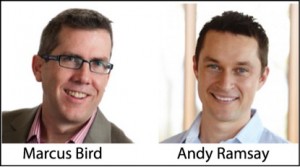Marcus Bird, MEI, Dip HSc Kin
Andy Ramsay, BHSc acup
When we went to school to learn the amazing modality that is our chosen profession, we were not told of the fate that was soon to befall us. We were dazzled by the bright lights and promises that if we were of service, that would be enough to have a full and busy practice, and that giving to and helping another person to live a “well” life would bring ultimate prosperity to our clients and ourselves. This promise – enhanced by the desire to do good, to share our message, and be the amazing healers we are – only heightens the frustration of reality for some. Dr Google prescribes the fix for any illness or disease, laughing in the face of our years of study, knowledge, and wisdom.
Build It and They Will Come?
There, in the spotlight of “primary healthcare provider,” the dream of “build it and they will come” pales into the truth that patients don’t just instantly gravitate to you in a flurry of awe and wonder. Here, in the reality of wellness business ownership, the cold hard facts of life are dealt out in spades, like the hungry casino taking its cut before you get a chance to play the odds. Our experience of this cold, harsh reality took the 2 of us years to decipher, like the code breakers of World War II who painstakingly spent hours upon hours to finally break the enigma code that helped win the war. We too had to find a way to break the code of struggle as natural healthcare providers.
The statistics for practitioners is not overly bright, depending on which statistics you follow. According to the Association of Accredited Naturopathic Medical Colleges (AANMC), the average income in a busy practice is $80 000 to $90 000 per year, and for those starting out, it is glummer at $25 000 to $30 000 per year.1 Meanwhile, LearningPath.org states that the average income for naturopathic physicians sits at $25 000 to $81 000 per year.2 Either way, the statistics could be better.
Overcoming our past struggle, which saw us beat the statistics to earn high 6-figure salaries, has now been put to good use helping other therapists. Supporting and mentoring practitioners, such as yourselves, helps them attract the abundance of clients, money and success that they deserve. We brought together the wounds and scars of practice-building to develop a system that puts the odds firmly back in our favor. Here the possibility of success finally shone like the bright lights of Friday night football! Had we finally found the secret of success as a wellness leader?
Building Trust & Relationship is Key
We all find ourselves in one of the most sensitive industries in the world, where potential patients won’t trust their health to any old practitioner. We know, as consumers, that we would rather place our trust in someone whom we know directly or through another trusted source. Therefore, the way that we market our business must focus on building trust with our potential audience rather than trying to push our services onto them. Marketing to build a relationship, rather than to sell, has to be a key focus of our efforts. It does not work to overlay the old marketing framework, borrowed from other industries, onto our goal. In this framework, sales marketing is the core focus, where the consumer is persuaded and convinced through a fear-based approach. Rather than attracting clients, this type of marketing repels our potential patients. Buyers in the wellness industry are sensitive to the “buy now and receive a free set of steak knives” approach to selling.
If we are to attract the clients we love to treat, we have to find a different approach than this. How we communicate with our potential market is critical to our business success. We have come to terms with the fact that we are all running our own businesses, that we are all wellness entrepreneurs, and thus that we have a responsibility to market ourselves creatively and effectively. Then, we can start to focus on the fact that how we communicate our message to the world is critical. We can no longer follow the teachings of marketing experts; rather, we must develop our own framework for connecting to, communicating with, and converting potential customers into patients.
To capture the power of this different approach, we have to make sure that the message we are sending out into the market is one that is not only attractive to potential customers, but that it is also aligned with how we want to be viewed in that market. This type of approach has 3 distinct facets (Figure 1).
Figure 1. Magnifying Glass Principal
 Alignment
Alignment
The first step is to make sure that our message is aligned with our true desire as a practitioner. We want a message that it is consistent with our passion, our experience, and our desire to heal. When we graduate from school, we are given the tools to heal a wide range of issues, illnesses, and pains. Our schools equip us well to deal with virtually any ailment that could potentially walk through our door. We then take this knowledge out into the world and share our newfound skills by saying that we have the ability to deal with many different issues that any person could be suffering from. What message does this approach send to your market? In our experience, it sends a confusing, scattered message that does not land well in the laps of our potential customers. Remember, we work in a highly sensitive market where we are not going to trust our health to just anyone. What we are looking for is someone who knows what we are dealing with, has a deep empathy and understanding of what we are going through, and – most importantly – has a wealth of experience in healing that issue. People are looking for a fix to a specific problem, and we need to represent the answer to this problem.
So, alignment is about making sure that we are choosing a topic, or topics, that we are either passionate about or have experienced first-hand (either personally or with friends and family members).
Focus
The second step is to make sure that we take this passion, experience, or desire, and deliver a focused message to the market. We need to make sure – from a purely marketing point of view – that we compartmentalize our message such that we speak only about the problems that our potential customer is facing. One of the rules of thumb we live by is to think of 1 topic, 1 person and 1 solution. So, rather than a mixed or convoluted message going out into the world, a clear, focused message is sent which is then easier for our potential customer to understand. We in turn become “easier to buy,” allowing customers to purchase and come and see us.
Education
The third step is to make sure that we deliver our message through “Education Marketing,” rather than the old paradigm of “Sales Marketing.” A lot has changed in the marketing industry with the advent of the internet. Marketers are now focused on educating the potential customer before asking for the sale. Trying to convince a stranger to “buy you” is very difficult, uncomfortable, and awkward, especially when you have not built any trust with them. Trust is the key word, because – like we said before – we don’t trust just anyone with our health. So, we need to build trust with our market before we ask them to buy.
Education Marketing is about giving away your best information for FREE! Yes, we said FREE! I know some of you might be a little scared about giving away your best information for free, but it is the pinnacle way to build trust with your audience. It also has the positive side effect of encouraging them to find out more, to learn more from you, and to eventually engage you as their practitioner.
When people see you gifting some of your best wisdom and knowledge for free, a few things go through their minds – firstly, how amazingly helpful the information is. Secondly, if you are giving away this good stuff, then you must have additional good stuff in your programs, products, or sessions. Thirdly, they can “try before they buy,” using your free information to help them to start feeling better. If it works for them, if they can get an immediate benefit, they are more likely to want to engage your services.
Summary
So, it’s as simple as: align, focus, educate. When we get this right, it is a bit like burning a leaf with a magnifying glass: the more focused we become, the faster and easier the leaf burns.
Over the next few months, we will be bringing you lots of marketing tips to help you book solid your local practice. We will be sharing the practical steps that we ourselves use, to help you to attract more clients, make more money, and have more time to do the things you want to do. In essence, our job is to help you attract an abundance of clients with whom you love to work, and who love to work with you, leading to better outcomes for your patients, and better outcomes for your practice.
 Andy Ramsey, BHSc Acup, and Marcus Bird, MEI, Dip HSc Kin, both had successful careers as practitioners – Andy as a Traditional Chinese Medicine doctor, and Marcus as a kinesiologist and counselor/coach. Both were clinic owners and in private practice. Andy and Marcus both experienced the struggle that most practitioners go through, which leads to low pay, overwork, and deep frustration. Having taught themselves a system to overcome this all-too-common situation, Andy and Marcus started the Wellness Leadership Academy and now teach other practitioners how to beat the statistics and attract more clients, make more money, and have more time to deliver their true message on the planet. They can be reached at marcus@wellnessleadershipacademy.com; and andy@wellnessleadershipacademy.com.
Andy Ramsey, BHSc Acup, and Marcus Bird, MEI, Dip HSc Kin, both had successful careers as practitioners – Andy as a Traditional Chinese Medicine doctor, and Marcus as a kinesiologist and counselor/coach. Both were clinic owners and in private practice. Andy and Marcus both experienced the struggle that most practitioners go through, which leads to low pay, overwork, and deep frustration. Having taught themselves a system to overcome this all-too-common situation, Andy and Marcus started the Wellness Leadership Academy and now teach other practitioners how to beat the statistics and attract more clients, make more money, and have more time to deliver their true message on the planet. They can be reached at marcus@wellnessleadershipacademy.com; and andy@wellnessleadershipacademy.com.
References:
- Career Trends in Naturopathic Medicine. June 20, 2012. Boucher Institute of Naturopathic Medicine. Available at: http://www.binm.org/blog/302/302-career-trends-in-naturopathic-medicine. Accessed January 13, 2015.
- Holistic Health Practitioner Careers: Salary Info and Job Description. LearningPath.org Web site. http://learningpath.org/articles/Holistic_Health_Practitioner_Careers_Salary_Info_Job_Description.html. Accessed January 13, 2015.

